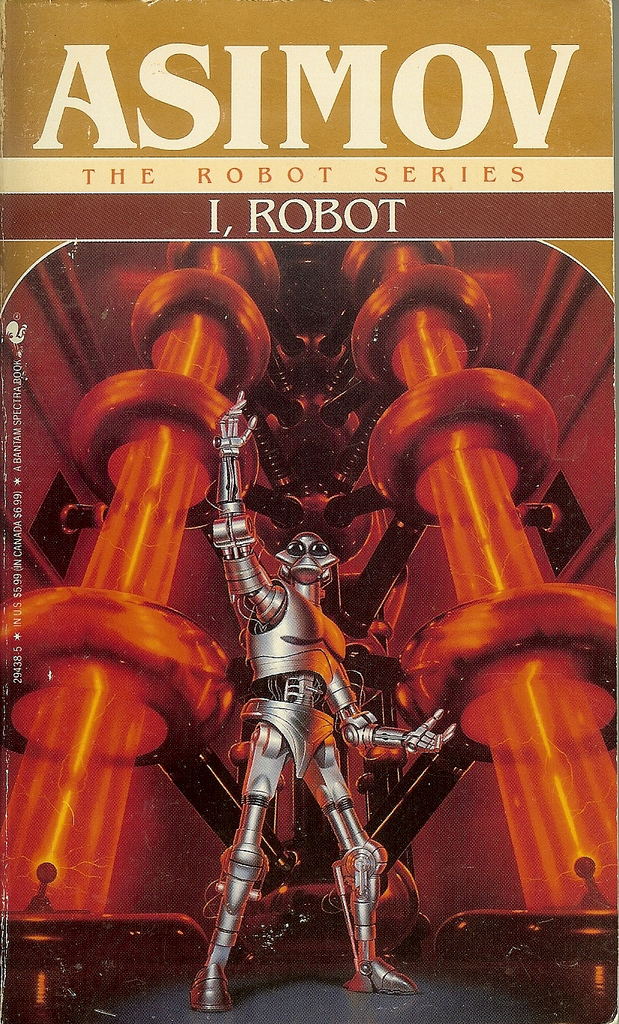
Robohub.org
A round up of robotics and AI ethics: part 1 principles

This blogpost is a round up of the various sets of ethical principles of robotics and AI that have been proposed to date, ordered by date of first publication. The principles are presented here (in full or abridged) with notes and references but without commentary. If there are any (prominent) ones I’ve missed please let me know.
Asimov’s three laws of Robotics (1950)
- A robot may not injure a human being or, through inaction, allow a human being to come to harm.
- A robot must obey the orders given it by human beings except where such orders would conflict with the First Law.
- A robot must protect its own existence as long as such protection does not conflict with the First or Second Laws.
I have included these to explicitly acknowledge, firstly, that Asimov undoubtedly established the principle that robots (and by extension AIs) should be governed by principles, and secondly that many subsequent principles have been drafted as a direct response. The three laws first appeared in Asimov’s short story Runaround [1]. This wikipedia article provides a very good account of the three laws and their many (fictional) extensions.
Murphy and Wood’s three laws of Responsible Robotics (2009)
- A human may not deploy a robot without the human-robot work system meeting the highest legal and professional standards of safety and ethics.
- A robot must respond to humans as appropriate for their roles.
- A robot must be endowed with sufficient situated autonomy to protect its own existence as long as such protection provides smooth transfer of control which does not conflict with the First and Second Laws.
These were proposed in Robin Murphy and David Wood’s paper Beyond Asimov: The Three Laws of Responsible Robotics [2].
EPSRC Principles of Robotics (2010)
- Robots are multi-use tools. Robots should not be designed solely or primarily to kill or harm humans, except in the interests of national security.
- Humans, not Robots, are responsible agents. Robots should be designed and operated as far as practicable to comply with existing laws, fundamental rights and freedoms, including privacy.
- Robots are products. They should be designed using processes which assure their safety and security.
- Robots are manufactured artefacts. They should not be designed in a deceptive way to exploit vulnerable users; instead their machine nature should be transparent.
- The person with legal responsibility for a robot should be attributed.
These principles were drafted in 2010 and published online in 2011, but not formally published until 2017 [3] as part of a two-part special issue of Connection Science on the principles, edited by Tony Prescott & Michael Szollosy [4]. An accessible introduction to the EPSRC principles was published in New Scientist in 2011.
Future of Life Institute Asilomar principles for beneficial AI (Jan 2017)
I will not list all 23 principles but extract just a few to compare and contrast with the others listed here:
6. Safety: AI systems should be safe and secure throughout their operational lifetime, and verifiably so where applicable and feasible.
7. Failure Transparency: If an AI system causes harm, it should be possible to ascertain why.
8. Judicial Transparency: Any involvement by an autonomous system in judicial decision-making should provide a satisfactory explanation auditable by a competent human authority.
9. Responsibility: Designers and builders of advanced AI systems are stakeholders in the moral implications of their use, misuse, and actions, with a responsibility and opportunity to shape those implications.
10. Value Alignment: Highly autonomous AI systems should be designed so that their goals and behaviors can be assured to align with human values throughout their operation.
11. Human Values: AI systems should be designed and operated so as to be compatible with ideals of human dignity, rights, freedoms, and cultural diversity.
12. Personal Privacy: People should have the right to access, manage and control the data they generate, given AI systems’ power to analyze and utilize that data.
13. Liberty and Privacy: The application of AI to personal data must not unreasonably curtail people’s real or perceived liberty.
14. Shared Benefit: AI technologies should benefit and empower as many people as possible.
15. Shared Prosperity: The economic prosperity created by AI should be shared broadly, to benefit all of humanity.
An account of the development of the Asilomar principles can be found here.
The ACM US Public Policy Council Principles for Algorithmic Transparency and Accountability (Jan 2017)
- Awareness: Owners, designers, builders, users, and other stakeholders of analytic systems should be aware of the possible biases involved in their design, implementation, and use and the potential harm that biases can cause to individuals and society.
- Access and redress: Regulators should encourage the adoption of mechanisms that enable questioning and redress for individuals and groups that are adversely affected by algorithmically informed decisions.
- Accountability: Institutions should be held responsible for decisions made by the algorithms that they use, even if it is not feasible to explain in detail how the algorithms produce their results.
- Explanation: Systems and institutions that use algorithmic decision-making are encouraged to produce explanations regarding both the procedures followed by the algorithm and the specific decisions that are made. This is particularly important in public policy contexts.
- Data Provenance: A description of the way in which the training data was collected should be maintained by the builders of the algorithms, accompanied by an exploration of the potential biases induced by the human or algorithmic data-gathering process.
- Auditability: Models, algorithms, data, and decisions should be recorded so that they can be audited in cases where harm is suspected.
- Validation and Testing: Institutions should use rigorous methods to validate their models and document those methods and results.
See the ACM announcement of these principles here. The principles form part of the ACM’s updated code of ethics.
Japanese Society for Artificial Intelligence (JSAI) Ethical Guidelines (Feb 2017)>
- Contribution to humanity Members of the JSAI will contribute to the peace, safety, welfare, and public interest of humanity.
- Abidance of laws and regulations Members of the JSAI must respect laws and regulations relating to research and development, intellectual property, as well as any other relevant contractual agreements. Members of the JSAI must not use AI with the intention of harming others, be it directly or indirectly.
- Respect for the privacy of others Members of the JSAI will respect the privacy of others with regards to their research and development of AI. Members of the JSAI have the duty to treat personal information appropriately and in accordance with relevant laws and regulations.
- Fairness Members of the JSAI will always be fair. Members of the JSAI will acknowledge that the use of AI may bring about additional inequality and discrimination in society which did not exist before, and will not be biased when developing AI.
- Security As specialists, members of the JSAI shall recognize the need for AI to be safe and acknowledge their responsibility in keeping AI under control.
- Act with integrity Members of the JSAI are to acknowledge the significant impact which AI can have on society.
- Accountability and Social Responsibility Members of the JSAI must verify the performance and resulting impact of AI technologies they have researched and developed.
- Communication with society and self-development Members of the JSAI must aim to improve and enhance society’s understanding of AI.
- Abidance of ethics guidelines by AI AI must abide by the policies described above in the same manner as the members of the JSAI in order to become a member or a quasi-member of society.
An explanation of the background and aims of these ethical guidelines can be found here, together with a link to the full principles (which are shown abridged above).
Draft principles of The Future Society’s Science, Law and Society Initiative (Oct 2017)
- AI should advance the well-being of humanity, its societies, and its natural environment.
- AI should be transparent.
- Manufacturers and operators of AI should be accountable.
- AI’s effectiveness should be measurable in the real-world applications for which it is intended.
- Operators of AI systems should have appropriate competencies.
- The norms of delegation of decisions to AI systems should be codified through thoughtful, inclusive dialogue with civil society.
This article by Nicolas Economou explains the 6 principles with a full commentary on each one.
Montréal Declaration for Responsible AI draft principles (Nov 2017)
- Well-being The development of AI should ultimately promote the well-being of all sentient creatures.
- Autonomy The development of AI should promote the autonomy of all human beings and control, in a responsible way, the autonomy of computer systems.
- Justice The development of AI should promote justice and seek to eliminate all types of discrimination, notably those linked to gender, age, mental / physical abilities, sexual orientation, ethnic/social origins and religious beliefs.
- Privacy The development of AI should offer guarantees respecting personal privacy and allowing people who use it to access their personal data as well as the kinds of information that any algorithm might use.
- Knowledge The development of AI should promote critical thinking and protect us from propaganda and manipulation.
- Democracy The development of AI should promote informed participation in public life, cooperation and democratic debate.
- Responsibility The various players in the development of AI should assume their responsibility by working against the risks arising from their technological innovations.
The Montréal Declaration for Responsible AI proposes the 7 values and draft principles above (here in full with preamble, questions and definitions).
IEEE General Principles of Ethical Autonomous and Intelligent Systems (Dec 2017)
- How can we ensure that A/IS do not infringe human rights?
- Traditional metrics of prosperity do not take into account the full effect of A/IS technologies on human well-being.
- How can we assure that designers, manufacturers, owners and operators of A/IS are responsible and accountable?
- How can we ensure that A/IS are transparent?
- How can we extend the benefits and minimize the risks of AI/AS technology being misused?
These 5 general principles appear in Ethically Aligned Design v2, a discussion document drafted and published by the IEEE Standards Association Global Initiative on Ethics of Autonomous and Intelligent Systems. The principles are expressed not as rules but instead as questions, or concerns, together with background and candidate recommendations.
A short article co-authored with IEEE general principles co-chair Mark Halverson Why Principles Matter explains the link between principles and standards, together with further commentary and references.
UNI Global Union Top 10 Principles for Ethical AI (Dec 2017)
- Demand That AI Systems Are Transparent
- Equip AI Systems With an “Ethical Black Box”
- Make AI Serve People and Planet
- Adopt a Human-In-Command Approach
- Ensure a Genderless, Unbiased AI
- Share the Benefits of AI Systems
- Secure a Just Transition and Ensuring Support for Fundamental Freedoms and Rights
- Establish Global Governance Mechanisms
- Ban the Attribution of Responsibility to Robots
- Ban AI Arms Race
Drafted by UNI Global Union‘s Future World of Work these 10 principles for Ethical AI (set out here with full commentary) “provide unions, shop stewards and workers with a set of concrete demands to the transparency, and application of AI”.
References
[1] Asimov, Isaac (1950): Runaround, in I, Robot, (The Isaac Asimov Collection ed.) Doubleday. ISBN 0-385-42304-7.
[2] Murphy, Robin; Woods, David D. (2009): Beyond Asimov: The Three Laws of Responsible Robotics. IEEE Intelligent systems. 24 (4): 14–20.
[3] Margaret Boden et al (2017): Principles of robotics: regulating robots in the real world
Connection Science. 29 (2): 124:129.
[4] Tony Prescott and Michael Szollosy (eds.) (2017): Ethical Principles of Robotics, Connection Science. 29 (2) and 29 (3).
tags: c-Politics-Law-Society, herotagrc




